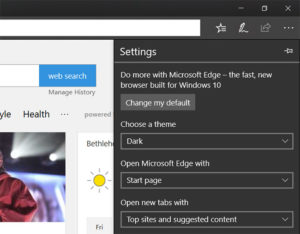

He founded PCWorld's "World Beyond Windows" column, which covered the latest developments in open-source operating systems like Linux and Chrome OS. He also wrote the USA's most-saved article of 2021, according to Pocket.Ĭhris was a PCWorld columnist for two years. Beyond the web, his work has appeared in the print edition of The New York Times (September 9, 2019) and in PCWorld's print magazines, specifically in the August 2013 and July 2013 editions, where his story was on the cover. With over a decade of writing experience in the field of technology, Chris has written for a variety of publications including The New York Times, Reader's Digest, IDG's PCWorld, Digital Trends, and MakeUseOf. Chris has personally written over 2,000 articles that have been read more than one billion times-and that's just here at How-To Geek. Now, it's built into Chrome.Ĭhris Hoffman is the former Editor-in-Chief of How-To Geek.
Microsoft edge dark mode install#
Previously, you could download and install browser extensions that automatically turned light websites dark. This is a brute-force solution, and it won't be as pretty as waiting for websites to enable their own shiny new dark themes. It's a little like using "Smart Invert" on an iPhone - light colors will turn bright, but it'll leave images alone.

Rather than waiting for millions of websites to jump on the dark mode bandwagon, Chrome's new "Force Dark Mode for Web Contents" option will turn all those bright websites dark. But most websites, even Google's own Calendar website, don't have automatic dark mode-or any dark mode. Websites can automatically switch to dark mode if you're using it, assuming the site supports this. Google Chrome already has a built-in dark mode. Google Chrome can forcibly enable dark mode on every website you visit, putting an end to those blinding white backgrounds on your nice dark desktop.


 0 kommentar(er)
0 kommentar(er)
